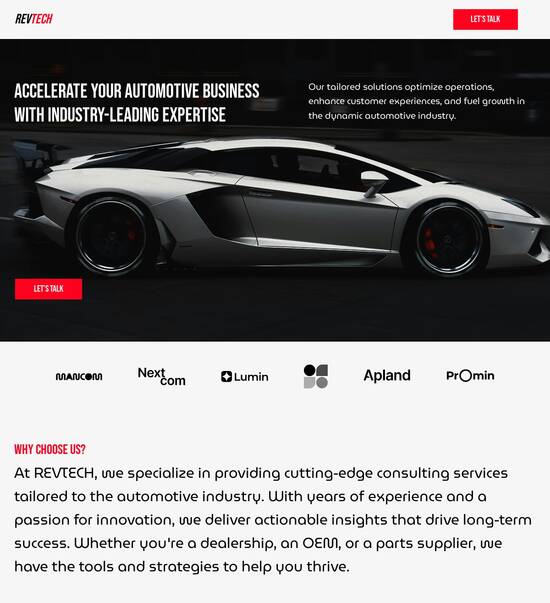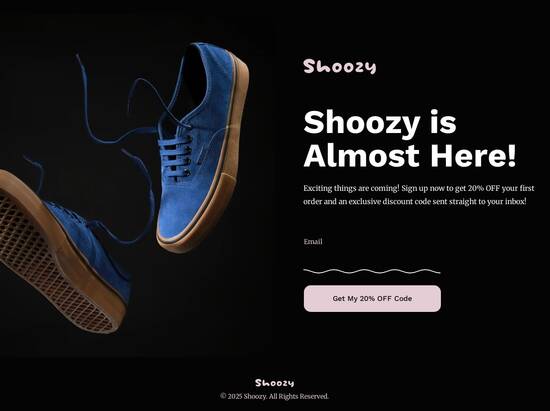
One page website template for recruiting agencies
Explore Similar TemplatesAbout template
Unlock the potential of our one page website template for recruiting agencies: flexible designs for all niches.
Recommended templates

Easy to build without coding
With the intuitive drag-and-drop builder, anyone on your team can create high-converting pages without any knowledge of code or design. Make enhancements to your landing page with custom widgets using Javascript, HTML/CSS, or third-party scripts.

Multiple layouts for any industry and goal
Select from 500+ landing page layouts built to boost conversions across industry-specific scenarios. Customize them by adjusting fonts, adding images, and generating on-brand content with the AI assistant. Quickly scale with Instablocks® and Global Blocks that you can save, reuse, and update globally.

Loads fast and looks polished on any device
Every template is responsive, which means they present professionally on any device and load blazingly fast with our Thor Render Engine. You can also power them up with Google AMP technology to deliver an unparalleled mobile experience and drive higher conversions.

Robust analytics & experimentation
Get real-time updates and reporting across all your devices, showing the number of visitors, conversions, cost-per-visitor, and cost-per-lead. Launch AI-powered experiments, run A/B tests, and use heatmaps to analyze user behavior, then optimize your landing page to maximize conversions.







Easy to build without coding
With the intuitive drag-and-drop builder, anyone on your team can create high-converting pages without any knowledge of code or design. Make enhancements to your landing page with custom widgets using Javascript, HTML/CSS, or third-party scripts.
Multiple layouts for any industry and goal
Select from 500+ landing page layouts built to boost conversions across industry-specific scenarios. Customize them by adjusting fonts, adding images, and generating on-brand content with the AI assistant. Quickly scale with Instablocks® and Global Blocks that you can save, reuse, and update globally.
Loads fast and looks polished on any device
Every template is responsive, which means they present professionally on any device and load blazingly fast with our Thor Render Engine.
Robust analytics & experimentation
Get real-time updates and reporting across all your devices, showing the number of visitors, conversions, cost-per-visitor, and cost-per-lead. Launch AI-powered experiments, run A/B tests, and use heatmaps to analyze user behavior, then optimize your landing page to maximize conversions.
All the features you need to build lead-generating landing pages
Explore more featuresLearn how to build top-performing landing pages for any goal
FAQs
Leading the way in building high-performing landing pages





An ultimate guide to optimizing landing page performance on Instapage
Optimizing landing page performance is critical for marketers aiming to enhance their digital campaigns. Instapage offers powerful tools that not only simplify page creation but also significantly boost conversion rates. Whether you're in business services, tech, or education, mastering landing page optimization on Instapage can drive exceptional ROI.
Understanding the fundamentals of landing page optimization
At its core, landing page optimization involves enhancing the elements and design of your webpage to convert visitors into leads or customers. Key aspects include crafting compelling headlines, utilizing effective call-to-action (CTA) buttons, and ensuring the page loads quickly. In the competitive US market, this optimization process is essential for standing out and capturing your audience's attention.
- Identify your target audience: Understand whom you're speaking to so you can tailor your message accordingly.
- A/B testing: Compare different versions of landing pages to see which layout or content converts better.
- Utilize heatmaps: Gain insights into how users interact with your page, helping you adjust content placement effectively.
Step 1: Leverage Instapage templates for faster deployment
Using the pre-built high-converting templates on Instapage can save your team valuable time and resources. With over 100 customizable options available, you can pick a template that resonates with your audience's needs. Each layout comes with lead generation elements that can be customized without any coding knowledge.
Step 2: Optimize your content for conversion
Creating high-quality content is crucial for enticing visitors. Aim for clear and concise messaging. Include compelling visuals that complement the text, and make use of dynamic text replacement to personalize the user experience. Implementing effective SEO strategies will increase visibility in search results.
- Use engaging visuals: Images and videos can significantly enhance user engagement.
- Craft persuasive copy: Highlight benefits clearly in your copy to create urgency and encourage sign-ups.
- Personalize user experience: Utilize data to tailor messaging that speaks directly to your audience's pain points.
Step 3: Implement ongoing optimization strategies
Endless refinement is vital. Utilize Instapage's analytics dashboard to track user behavior and performance metrics. Set specific KPIs, and don't hesitate to iterate based on real data and user feedback.
- Monitor key metrics: Regularly check bounce rates, conversion rates, and engagement levels.
- Solicit user feedback: Use surveys or feedback forms to understand user experience issues.
- Conduct regular reviews: Keep pace with industry trends and adjust your strategies accordingly.
In conclusion, utilizing these steps can dramatically improve the performance of your landing pages on Instapage. Employing a structured approach ensures that your efforts lead to increased conversions and revenue.
Ready to supercharge your landing pages? Start leveraging Instapage’s unbeatable tools today and watch your conversion rates soar!
People also ask about One page website template for recruiting agencies
The power of one page website templates in recruitment: A deep dive into functionality and performance
Understanding the importance of one page websites for recruiting agencies
The landscape of recruitment has transformed remarkably over the years, necessitating a robust online presence for agencies. As potential candidates increasingly look to the internet for job opportunities, having a well-crafted website becomes essential. User-friendly web design is not just an aesthetic choice; it plays a crucial role in attracting top talent. A streamlined website allows agencies to showcase their unique value propositions, highlight job openings, and provide information quickly.
The choice of a one page format has specific advantages for recruitment agencies. First, it allows for agility in communication. With focused messaging, candidates can understand the agency's offerings without sifting through excessive information. Second, a one page design enhances user experience by ensuring quick navigation. Candidates can locate essential information right away, reducing frustration and encouraging them to engage with the content provided.
Unpacking the core features of a one page template
A well-crafted one page website template is built around features that facilitate easy customization and efficient information delivery. Many templates come with an intuitive drag-and-drop interface that empowers users to create unique designs without the need for coding knowledge. This simplicity allows recruitment agencies to focus on what matters: connecting with potential candidates. Pre-designed sections such as job listings, testimonials, and about us pages are tailored specifically for recruitment needs, providing a solid framework that can be personalized further.
Design elements are also pivotal. The incorporation of dynamic visuals—such as colors and fonts—affects a visitor's perception of the agency. For instance, using warm colors can evoke friendliness and openness, while professional fonts can lend credibility. Optimizing visual hierarchy is important too. Strategic use of layout and spacing can guide candidates’ eyes toward essential information, ensuring they absorb the key messages efficiently.
The role of interactive elements in engagement
Interactive elements play a significant role in engaging candidates more deeply. Incorporating video testimonials from satisfied clients or employees can significantly enhance candidate engagement. Best practices suggest that these videos should be brief yet genuine, enabling visitors to relate to the agency's culture and values quickly. Moreover, content strategies such as blogs or FAQ sections that resonate with potential hires can establish a robust connection, making candidates feel more informed and important.
Organizing information effectively is equally critical. Utilizing dynamic columns can enhance readability by segmenting text, making it easier for candidates to digest essential information. Additionally, a responsive layout ensures that the website performs optimally on mobile devices. Given that a significant portion of job seekers uses their smartphones, having a mobile-optimized site is necessary to capture leads effectively.
Implementing advanced functional capabilities
Advanced functionalities can significantly improve user interaction on recruitment websites. Event listeners, such as `document.addeventlistener`, enhance user engagement by providing instant feedback to form submissions or newsletter sign-ups. For instance, when a candidate submits their resume, a well-implemented event listener can trigger a thank-you message or a redirect to a follow-up page, creating a seamless experience that encourages interaction.
Furthermore, utilizing lazy loading techniques can maintain website speed and performance. Employing tools like `iolazy` ensures that images do not hinder loading times which is especially important for image-heavy designs. This enhancement improves user experience, as frustrated visitors waiting for slow-loading sites may leave without engaging with the content at all.
Essential content strategies for effective messaging
Creating compelling headers and sub-headers is crucial in attracting candidates’ attention. Techniques that encourage impact include using action-oriented words and posing intriguing questions that draw in users. For instance, a header that asks 'Ready to take your career to the next level?' can prompt candidates to explore further. In addition to powerful headers, strategizing content for clarity is vital. Formatting tips include utilizing bullet points and short paragraphs to enhance readability, ensuring that crucial information stands out.
Effective copywriting techniques also contribute to persuasive recruitment narratives. Candidates want to feel addressed and understood, so using a conversational tone while outlining what the agency is offering can build trust. Highlighting unique opportunities, company culture, and clear paths for growth through storytelling techniques can make the agency more appealing, ultimately driving applications.
Effective image use: Visual stories in recruitment
Selecting the right images is crucial for portraying the company's culture and mission effectively. High-quality visuals not only enhance the overall aesthetic of the website but also serve to communicate the agency's values and principles rapidly. Images showcasing diverse teams at work can reinforce messages of inclusivity and engagement, aligning the agency closely with candidates who prioritize these attributes.
Moreover, optimizing image loading and display is essential for performance. Techniques such as `lazy loading` can ensure that images load efficiently without hampering the overall website speed. By using these methods, agencies can provide quality visuals without sacrificing the user experience, allowing candidates to focus on the content rather than waiting for images to appear.
Advanced footer design: Beyond basic contact information
The footer of a one page website should not be an afterthought. Instead, it can be utilized for enhanced navigation. Beyond basic contact information, the footer can link to social media channels, additional resources, or even a brief about the agency. This extra layer of information provides candidates with various ways to connect and engage with the agency, rounding out a comprehensive user experience.
Additionally, including essential legal and compliance information in the footer is vital. Privacy policies and terms and conditions should be clearly stated, ensuring transparency with users. This incorporation not only builds trust but also helps to maintain compliance with regulations, especially important in sectors involving personal data.
The role of performance metrics and problem identification
Tracking user engagement and effectiveness is crucial for recruitment agencies. Monitoring performance metrics can reveal how well the website meets its objectives. Key performance indicators (KPIs) such as bounce rates and exit pages can provide valuable insights. Analyzing these metrics helps identify potential problems, indicating whether users find the content engaging or if structure changes may be needed.
Based on gathered data insights, agencies can adapt strategies for design improvements. Using analytics to understand user behavior allows for iterative developments that enhance engagement over time, creating a cycle of continuous optimization. Engaging with data not only supports growth but also aligns the agency's offerings with the expectations of the candidates.
Download panel features: Delivering added value
Incorporating downloadable resources on a one page website can enhance the value provided to candidates. Offering content such as eBooks or guides not only attracts leads but also positions the agency as a knowledgeable entity in the industry. This strategy allows users to engage with the content more deeply and provides an incentive to leave their contact information.
Best practices for structuring the download panel involve clear navigation and accessibility. Categories can help users quickly find the material they need, while enticing visuals can make the resources look appealing. Furthermore, ensuring that the download process is simple and straightforward minimizes friction and encourages more candidates to access the content.
Future trends in one page website templates for recruiting
Looking ahead, one page website templates are likely to evolve with emerging technologies. For instance, the integration of AI-driven tools can personalize candidate experiences, tailoring content based on user behavior and preferences. This personalization can significantly enhance engagement by ensuring that candidates receive relevant information promptly.
Moreover, design trends are continuously evolving. As user expectations shift, recruitment agencies should remain vigilant, adapting their templates to align with modern aesthetics and functionalities. Elements such as minimalist design, immersive elements, and increased use of interactive components are all trends that agencies should consider, ensuring their websites remain relevant and appealing to prospective candidates.
Conclusion: The transformative power of one page website templates for recruitment agencies
Summarizing the discussion on one page website templates reveals their myriad benefits and features that reimagine recruitment and candidate engagement. The ability to present information succinctly, coupled with advanced functionalities, allows agencies to engage more effectively with potential candidates. With a focus on user experience, agencies can create welcoming and informative environments that encourage application submissions.
As digital recruitment strategies continue to evolve, the significance of ongoing adaptation and innovation in web design cannot be overstated. Agencies that invest in effective one page website templates will position themselves to attract top talent, ensuring they remain competitive in an ever-changing market.
Ready to skyrocket conversions?
Supercharge your ad campaigns with high-performing landing pages
Get started














